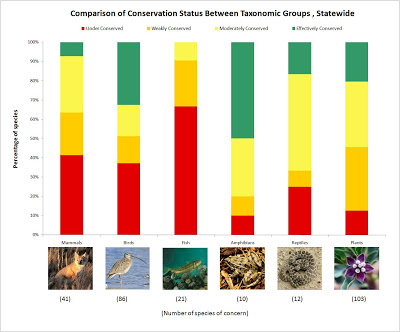Conservationists and planners need methods to identify priority areas for conservation, information on how to characterize the relative importance, quality, and urgency of these areas, and a means to measure conservation success on a regional or statewide basis over time. In order to assist the Colorado office of The Nature Conservancy with their “Measures of Success” program, and to provide biodiversity status information to other organizations in Colorado, the Colorado Natural Heritage Program has developed a prototype analysis of the status of Colorado’s biodiversity, using a “scorecard” approach.
There are over 2,500 native plant species within Colorado. CNHP tracks over 500 of the rarest of these plants. The 103 most at-risk of these species for which we have sufficient data were included in this initial biodiversity scorecard. Likewise, out of the 500 native vertebrate animal species in Colorado, we evaluated 113 of the most at-risk species (our knowledge of the rarest invertebrates is still sadly lacking).
At-risk status does not translate directly into federal legal protection. Of all the at-risk species in our state, a much smaller number are listed as threatened or endangered under the Endangered Species Act:
- Amphibians = 0
- Birds = 5
- Fish = 5
- Mammals = 5
- Reptiles = 0
- Plants = 13

Plants, animals, and ecological systems can only be considered effectively conserved when their biodiversity status is viable, threats have been abated, and land management/protection is sufficient to ensure the long-term persistence of the element. For more information about how we calculated these scores and which species we evaluated, see our draft Biodiversity Scorecard.




